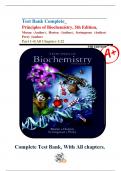Test Bank Complete_
Principles of Biochemistry, 5th Edition,
Moran (Author), Horton (Author), Scrimgeour (Author)
Perry (Author)
Part 1-4| All Chapters 1-22
5TH EDITION
,PART ONE; INTRODUCTION ___________________________________________________ 3
Chapter 1 Introduction To Biochemistry _________________________________________ 3
Chapter 2 Water ______________________________________________________________ 19
PART TWO; STRUCTURE AND FUNCTION _______________________________________ 36
Chapter 3 Amino Acids And The Primary Structures Of Proteins _________________________ 36
Chapter 4 Proteins: Three-Dimensional Structure And Function _________________________ 56
Chapter 5 Properties Of Enzymes _________________________________________________ 75
Chapter 6 Mechanisms Of Enzymes _______________________________________________ 93
Chapter 7 Coenzymes And Vitamins ______________________________________________ 109
Chapter 8 Carbohydrates _______________________________________________________ 124
Chapter 9 Lipids And Membranes ________________________________________________ 139
PART THREE METABOLISM AND BIOENERGETICS ________________________________ 155
Chapter 10 Introduction To Metabolism ___________________________________________ 155
Chapter 11 Glycolysis __________________________________________________________ 171
Chapter 12 Gluconeogenesis, The Pentose Phosphate Pathway, And Glycogen Metabolism _ 188
Chapter 13 The Citric Acid Cycle _________________________________________________ 203
Chapter 14 Electron Transport And ATP Synthesis ___________________________________ 219
Chapter 15 Photosynthesis _____________________________________________________ 235
Chapter 16 Lipid Metabolism ____________________________________________________ 250
Chapter 17 Amino Acid Metabolism ______________________________________________ 266
Chapter 18 Nucleotide Metabolism_______________________________________________ 280
PART FOUR; BIOLOGICAL INFORMATION FLOW _________________________________ 295
Chapter 19 Nucleic Acids _______________________________________________________ 295
Chapter 20 DNA Replication, Repair, And Recombination _____________________________ 312
Chapter 21 Transcription And RNA Processing ______________________________________ 328
Chapter 22 Protein Synthesis ____________________________________________________ 343
,PART ONE; INTRODUCTION
Chapter 1 Introduction To Biochemistry
MULTIPLE CHOICE
1. Wohler Showed That A Chemical Found Only In Living Organisms Can Be Made
From Inorganic Substances When He Synthesized:
A) Ammonium Cyanate
B) Amino Acids
C) Urea
D) Uric Acid
ANS: C
Feedback:
Urea Was The First Organic Compound Synthesized From Inorganic Materials,
Demonstrating That Organic Compounds Could Arise From Non-Living Sources.
; A) Ammonium Cyanate Is An Inorganic Compound; B) Amino Acids Can Be
Formed From Various Precursors, But Urea Is Specifically Significant In This
Context; D) Uric Acid Is A Nitrogenous Waste, Not Directly Synthesized From
Inorganic Sources.
Page Ref: Section 1-1
2. The Lock-And-Key Theory Described The Action Of:
A) Enzymes As Keys That Fit Different Chemicals.
B) Substrates As Keys That Fit Different Enzymes.
C) Enzymes As Locks That Fit Other Enzymes.
D) Substrates As Locks That Fit Different Enzymes.
ANS: B
Feedback:
This Theory Illustrates How Specific Substrates Fit Into Specific Enzymes, Much
Like A Key Fits Into A Lock.
; A) Enzymes Are The Locks, Not Keys; C) This Option Misrepresents The Roles Of
Enzymes And Substrates; D) This Incorrectly Reverses The Roles Of Enzymes And
Substrates.
Page Ref: Section 1-1
3. According To Crick's Central Dogma Of Molecular Biology, There Can Be NO
Transfer Of Information From:
A) DNA To RNA.
B) RNA To RNA.
,C) RNA To Protein.
D) Protein To RNA.
ANS: D
Feedback:
The Central Dogma States That Information Flows From DNA To RNA To Protein,
But Not From Protein Back To RNA.
; A), B), And C) Are All Valid Transfer Pathways According To The Central Dogma.
Page Ref: Section 1-1
4. What Is The Correct Order In Which These Key Breakthroughs In Biochemistry
Occurred?
I. Watson And Crick DNA Structure
II. Crick Central Dogma
III. Avery, Macleod And Mccarty DNA Work On Streptococcus
IV. Widespread Use Of Computers
A) I, II, III, IV
B) III, I, II, IV
C) II, I, III, IV
D) IV, III, I, II
ANS: B
Feedback:
This Sequence Correctly Outlines The Historical Timeline Of These Breakthroughs.
; A), C), And D) Misplace Key Developments In Biochemistry And Computer
Science.
Page Ref: Section 1-1
5. Which Elements Account For More Than 97% Of The Weight Of Most
Organisms?
A) C, H, N, Mg, O, S
B) C, H, N, O, P, S
C) C, H, N
D) Fe, C, H, O, P
E) Ca2+, K+, Na+, Mg2+, Cl-
ANS: B
Feedback:
These Elements Are Fundamental To Biological Macromolecules And Thus
Constitute The Majority Of An Organism's Mass.
; A) Includes Less Significant Elements; C) Is Incomplete; D) And E) Also Include
Elements Not Primarily Found In Most Organisms.
Page Ref: Section 1-2
, 6. Which Linkage(S) Occur Extensively In Nucleotides?
A) Amide.
B) Phosphoanhydride.
C) Phosphate Ester.
D) Ether.
E) Both B And C Above.
ANS: E
Feedback:
Both Phosphoanhydride And Phosphate Ester Linkages Are Crucial In Nucleotide
Structure.
; A) Amide Linkages Are Not Significant In Nucleotides; D) Ether Linkages Are Not
Typical In Nucleotides.
Page Ref: Section 1-2
7. Which Functional Group Is Shown?
A) Primary Amine.
B) Acyl.
C) Amide.
D) Anhydride.
E) Nitrile.
ANS: C
Feedback:
The Amide Group Is Characterized By A Carbonyl Group Linked To A Nitrogen
Atom.
; A) A Primary Amine Lacks A Carbonyl; B) Acyl Groups Differ In Structure; D)
Anhydrides Have Different Bonding; E) Nitriles Contain A Carbon-Nitrogen Triple
Bond.
Page Ref: Section 1-2
8. Proteins In Biological Membranes May Be:
A) Porous.
B) Attached To The Membrane Surface.
C) Span The Membrane.
D) All Of The Above.
E) B And C Only.
ANS: D
Feedback:
Membrane Proteins Can Exhibit Various Properties, Including Spanning Or
Attaching To Membranes.
; A) Is Misleading, As Proteins Themselves Are Not Porous; E) Excludes A Valid
Option.




